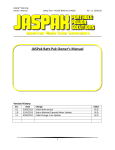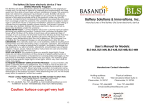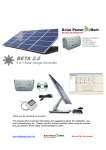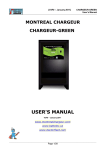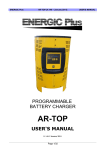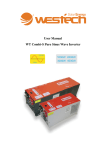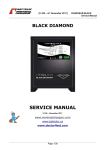Download 12151 - BatteryMINDers
Transcript
BatteryMINDer® Model 12151 INSTRUCTION MANUAL BatteryMINDer® Model 12151* Charger / Maintainer / Full-Time Desulfator VDC Electronics, Inc. 147 D Woodbury Rd. Huntington, NY 11743 U.S.A. www.batteryminders.com [email protected] *NOT for use with Aviation Type 12-V Batteries READ AND SAVE THESE INSTRUCTIONS Rev. A-072610 Rev. A-072610 Page P/N VDC 12151-MNL P/N VDC 12151-MNL BatteryMINDer® Model 12151 Your new battery charger has been designed and manufactured to provide years of reliable service. This charger cannot be used on positive ground systems without conversion (see MOUNTING CHARGER FOR CONTINUOUS USE). Proper use and care can prolong the life of the charger. This Operator’s Manual contains information regarding safety, operation, maintenance and storage of your new battery charger. Make sure that you, and anyone else who will be using this charger, are familiar with this information. IMPORTANT SAFETY INSTRUCTIONS SAVE THESE INSTRUCTIONS WARNING Read, understand and follow instructions found in the operator’s manual before using your battery charger. Failure to follow operating instructions may result in property damage or serious injury. This manual contains important safety and operating instructions. • Use of an attachment not recommended or sold by the manufacturer may result in a risk of fire, electric shock or injury to persons. • To reduce the risk of damage to electric plug and cord, pull by plug rather than cord when disconnecting charger. WARNING RISK OF FIRE: Never smoke or allow a spark or flame in the vicinity of the battery or the engine. • Use of an improper extension cord could result in a risk of fire and electric shock. If an extension cord must be used, make sure: 1. that pins on plug of extension cord are the same number, size, and shape as those of plug on charger; 2. that extension cord is properly wired and in good electrical condition; 3. that wire size is large enough for ac ampere rating of this charger as indicated in the following table (see next page). Rev. A-072610 Page P/N VDC 12151-MNL BatteryMINDer® Model 12151 RECOMMENDED MINIMUM AWG WIRE SIZE FOR EXTENSION CORDS FOR THIS BATTERY CHARGER Length of Cord, Feet 25 50 100 150 AWG Size of Cord 18 18 18 16 • Do not operate charger with damaged ac line cord or plug – replace them immediately. • Do not operate charger if it has received a sharp blow, been dropped or otherwise damaged in any way; take it to a qualified service person. WARNING RISK OF EXPLOSIVE GASES: Working in the vicinity of a lead acid battery is dangerous. Batteries generate explosive gases during normal battery operation. Always work in a well ventilated area. • Do not disassemble charger; take it to a qualified service person when service or repair is required. Incorrect reassembly may result in a risk of electric shock or fire. WARNING FLYING DEBRIS RISK: Always wear safety equipment when working with batteries or chargers to protect yourself from flying debris, acid spills or other objects in and around an engine compartment. • To reduce risk of electric shock, unplug charger from outlet before attempting any maintenance or cleaning. For this reason, it is critical that each time before using your charger, you read this manual and follow the instructions exactly. To reduce the risk of battery explosion, follow these instructions and those published by battery manufacturer and manufacturer of any equipment you intend to use in vicinity of battery. Review cautionary markings on these products and on engine. Rev. A-072610 Page P/N VDC 12151-MNL BatteryMINDer® Model 12151 CAUTION – Connect or disconnect the battery clamps only when the ac line cord is disconnected or arcing or burning may result. CAUTION – Do not expose to rain; replace defective cords or wires immediately. PERSONAL PRECAUTIONS 1. Someone should be within range of your voice, or close enough to come to your aid, when you work near a lead-acid battery. 2. Have plenty of fresh water and soap nearby in case battery acid contacts skin, clothing or eyes. 3. Wear complete eye protection and clothing protection. Avoid touching eyes while working near battery. 4. If battery acid contacts skin or clothing, wash immediately with soap and water. If acid enters eye, immediately flood with running cold water for at least 10 minutes and get medical attention immediately. 5. Be extra cautious to reduce risk of dropping a metal tool onto battery. It might spark or short-circuit the battery or other electrical part that may cause an explosion. 6. Remove personal metal items such as rings, bracelets, necklaces and watches when working near a lead-acid battery. A lead-acid battery can produce a short-circuit current high enough to weld a ring or the like to metal, causing a severe burn. 7. Use this charger for charging LEAD-ACID batteries only. It is not intended to supply power to a low voltage electrical system other than in an automotive application. Do not use battery charger for charging dry-cell batteries that are commonly used with home appliances. These batteries may burst and cause injury to persons and damage to property. 8. NEVER charge a frozen battery. 9. If it becomes necessary to remove the battery from the vehicle to charge, always remove grounded terminal from battery first. Make sure all accessories in the vehicle are off, so as not to cause an arc. 10. Be sure area around battery is well ventilated while battery is being charged. Gases can be forcefully blown away, by using a piece of cardboard or other non-metallic material, such as a fan. 11. Add distilled water in each cell until battery acid reaches level specified by battery manufacturer. This helps purge excessive gas from cells. Do not overfill. For a battery without cell caps, carefully follow manufacturer’s recharging instructions. 12. Study all battery manufacturer’s specific precautions such as removing or not removing cell caps while charging and recommended rates of charge. Rev. A-072610 Page P/N VDC 12151-MNL BatteryMINDer® Model 12151 MOUNTING CHARGER FOR CONTINUOUS USE WARNING – Never alter AC line cord or plug provided. If it will not fit in the outlet, have the proper outlet installed by a qualified electrician. Improper connection can result in the risk of electric shock. 1. Fasten the supplied mounting bracket to the charger with the provided hardware as illustrated in Figure 1. 2. Slide the bottom flange of the mounting bracket under the Figure 1. Charger battery. The battery weight will Mounting hold the charger in place. 3. Check polarity of battery posts. Positive (POS, P, +) battery post usually has larger diameter than Negative (NEG, N, –) post. Determine which battery post is grounded (connected) to the chassis. If Negative post is grounded to chassis (as in most vehicles), see step a. If Positive post is grounded to the chassis, see step b. a) For negative-grounded vehicle, connect Positive (RED) lug from charger to Positive (POS, P, +) ungrounded battery post. Connect Negative (BLACK) lug to vehicle chassis or engine block, away from battery. Do not connect lug to carburetor, fuel lines, or sheet metal body parts. Make the connection to a heavy gauge metal part of the frame or engine block. b) If you have a positive ground system in your vehicle, you must mark the two DC output cable Figure 2. Terminal conductors with the color currently on each lug Connections and remove the attached battery lugs. Switch the lugs with new lugs of the same size but on opposite conductors. Put the new, larger lug on the conductor that is black (must remain identified as black or negative) and the new smaller lug on the conductor that is red (must remain identified as red or positive). The larger lug always connects to the battery and the smaller lug connects to the engine block or chassis, away from the battery. For positive-grounded vehicle, connect Negative (BLACK) clip from charger to Negative (NEG, N, –) ungrounded post of battery (see MOUNTING Rev. A-072610 Page P/N VDC 12151-MNL BatteryMINDer® Model 12151 CHARGER FOR CONTINUOUS USE). Connect Positive (RED) clip to vehicle chassis or engine block away from battery. Do not connect lug to carburetor, fuel lines or sheet metal body parts. Make the connection to a heavy gauge metal part of the frame or engine block. If problems arise while trying to connect the output leads, solicit the aid of your local auto supply store to find a suitable connection device for your application. OPERATING INSTRUCTIONS This charger uses a voltage regulating control circuit that continually monitors the battery voltage and automatically turns the output on and off, safeguarding against overcharge. This battery charger is designed to remain connected to the battery. However, if it becomes necessary to disconnect the charger, disconnect AC line cord first, remove lug from vehicle chassis (ground) and then remove the lug from battery terminal. WARNING A spark near the battery may cause the battery to explode. • To reduce risk of a spark near battery, position AC and DC line cords to reduce the risk of damage by hood, door or moving engine part. • Stay clear of fan blades, belts, pulleys and other parts that can cause personal injury. 1. Connect the battery charger ac line cord (through a UL approved extension cord) to a 120 Volt AC power outlet. Make sure the extension cord is in good condition and the wire size is large enough for the for the ac ampere rating of the charger (see RECOMMENDED MINIMUM AWG WIRE SIZE FOR EXTENSION CORDS FOR THIS BATTERY CHARGER). 2. Once the battery charger has been properly connected to the battery and the ac outlet, the GREEN LED will illuminate continuously indicating the battery is being charged. Depending on the state of charge at the time the charger is connected to the ac outlet, after a certain amount of time you will notice that the LED is flashing, indicating that the battery is fully charged and in maintenance mode. Rev. A-072610 Page P/N VDC 12151-MNL BatteryMINDer® Model 12151 The BatteryMINDer charges your battery (LED solid GREEN) to full voltage first before it automatically goes into the maintenance/desulfation mode. Then the LED blinks GREEN during the desulfation - maintenance mode. The battery is now charged. 3. The charger design incorporates reverse battery and short circuit protection by measuring a small battery voltage of the proper polarity before the charger turns the charge output on. For this reason, the battery voltage must measure at least 8.5 Vdc before the charger will charge the battery. CHARGER MAINTENANCE AND CARE A minimum amount of care can keep your battery charger working properly for years. Just as with any appliance or tool, keep your battery charger clean and dry. Occasionally cleaning the case and cables with a dry or slightly damp cloth will prolong the life of your charger. Rev. A-072610 Page P/N VDC 12151-MNL BatteryMINDer® Model 12151 FOR REPAIR OR REPLACEMENT Return Merchandise Authorization Note: If your questions relate to safety concerns, please contact: [email protected] or if a potentially hazardous emergency may exist cease using the product immediately and call (800) 379-5579 ext. 202 (ET) Monday – Friday or contact our tech support at ext. 206. Standard operating questions, clearly answered in this manual, will not be answered by phone. Guarantee and Warranty Rev. A-072610 Page P/N VDC 12151-MNL














